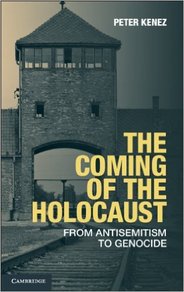I have uploaded some summary notes from the session with Darius' kind permission HERE. From a specifically teaching perspective note how Darius' use of the following helped hold that whole four hour session together, much like a sequence of lessons:
- A clear overall set of overall aims - to unpick our conceptual frameworks about the Holocaust and begin to reconstruct them and challenge them
- An overarching enquiry question to tie it all together - Who killed Barney Greenman?
- Clear and detailed subject knowledge deployed to ellaborate, illustrate, challenge and hook interest
- Activities which helped develop, deepen and challenge thinking whatever your prior knowledge on the Holocaust

As ever, one of the big issues in teaching any subject effectively is knowing the content and context itself. Darius noted that too often Holocaust teaching has very general purposes and fails to engage properly and historically with the subject. In order you broaden your own historical understadning of the Holocaust you may wish to have a look at:
"The Coming of the Holoaust" by Peter Kenez. I have put a review HERE, but Kenez tries to engage in the reasons for the Holocaust, but also its varied impacts in different European countries. He also has an autobiography looking at his own experience of living with antisemitism in his "Varieties of Fear" HERE. I like Peter's book because it is written from a clear perspective of trying to explain the Holocaust in a manner which goes beyond the Hitler & top Nazis argument.
"The Story of the Jews" by Simon Schama. This is both a book and a TV series - you can find a link HERE. If you know little about the history of Jews and Judaism, Schame is an excellent way into the background of the Jewish experience. This is especially important in seeing the contributions made by Jews to European society.
"Beatrice and Virgil" by Yann Martel. I seem to have lost my review for this one, but you can find a link to another one HERE. It deals with the issue of Holocaust fiction versus history. It is certainly a challenging read. I am still not sure if I think this is brilliant or awful, but would really like your thoughts.
The Holocaust Learning website and Holocaust Learning Project are archiving and cataloging the stories of victims of the Holocaust who now live in Yorkshire. This is a brilliant project and a great way to engage with the lives of victims before the events as well as their lives after. You will find all of Iby Knill's story here as well.
Using film when teaching the Holocaust. This was a session run by Jo Fox at Durham University unpicking how film and popular film might be understood in the context of the Holocaust. The notes are HERE. This is particularly good for challenging conceptual frameworks which hold that propaganda swayed Germans. Jo looks at the comparative failure of the Eternal Jew as a film and a piece of propaganda. Conversely she argues that films like Jud Suss were much more subtle and effective.

There are obviously some brilliant resources which UCL are making available with regard to the "Being Human?" approach. Here are just a few other resources which you may find helpful as ways into teaching the Holocaust. I am not holding the PowerPoints up as excellent examples, but they may provide a starting point.
Unpicking frameworks about perpetrators: One way into considering frameworks about perpetrators is to look at those who actually took part in mass killings. Karl Kretschmer was an Einsatzkommando. His letters to his family are a way to really consider what is meant by a perpetrator. Using the first letter from the PowerPoint, students tend to assume he is a victim of the Holocaust - something which comes from their existing framework. The lesson then challenges the view and asks why Karl participated. This unpicks notions that Karl was forced to take part by challenging this with evidence. Students are effectively reshaping their conceptual framework about what it meant to be a perpetrator. It is important to note that Kretschmer was not in a concentration camp as well. The PowerPoint including the two extracts from Karl is HERE, some documentation showing what Karl Kretschmer's Einsatzgruppe did is HERE, and some extracts on how much choice people had in participation is HERE and a similar accompanying resource HERE.
Broadening definitions of victims. The story of Hans Frank is one way to engage students with the idea that multiple groups of people were targeted by the Nazis. However it is also a way to begin to understand the unique experiences of disabled victims of the Nazis. You can find the story HERE.
Unpicking frameworks about remembering the Holocaust: This needs to be used carefully but can make a useful way to draw together thinking about the Holocaust. The resource revolves around a real stag tour advert for an "Auschwitz Experience Weekend". The discussion could be taken in any direction but in the example here it has been used to address the issue of what is acceptable in remembering the Holocaust. The resource itself is HERE and an associated PowerPoint is HERE.


 RSS Feed
RSS Feed
